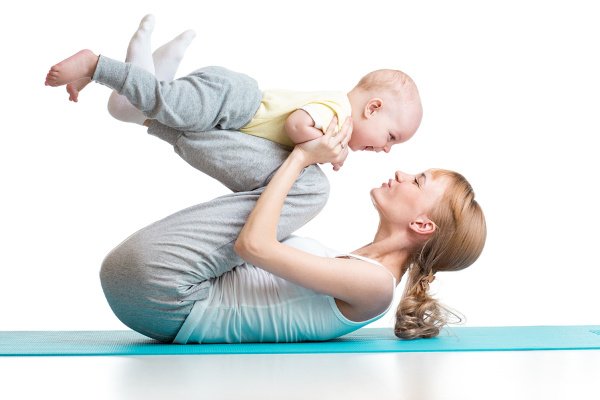
If you’re pregnant or recently gave birth, your OBGYN may have discussed the importance of postpartum pelvic floor exercises as part of your recovery, which probably went in one ear and out the other. Many new moms are too tired and overwhelmed to give their pelvic floor a second thought after childbirth. Between feedings, diaper changes, laundry, and sleep deprived nights, it’s hard to find the time to pee let alone do your kegels, am I right?
For those who aren’t in the know, the pelvic floor muscles support the pelvic organs, including the vagina, bladder, uterus, small bowel, and rectum. During pregnancy and childbirth, these supporting muscles become stretched and weakened, which is why some women experience urinary and/or bowel incontinence.
As you age – and if you have additional pregnancies – your pelvic floor muscles can be further weakened, resulting in something called ‘pelvic organ prolapse’. When this occurs, one or more of your pelvic organs drops from its normal position and moves into or outside of your vaginal canal or anus, which can cause feelings of pressure and fullness in the lower belly, vaginal spotting/bleeding, painful intercourse, urinary incontinence, and constipation. A prolapse can occur for many different reasons, including pregnancy, childbirth, hysterectomy, constipation, chronic coughing due to respiratory problems, being obese, and anything else that puts pressure on your belly.
If you’re looking for postpartum pelvic floor exercises to assist with healing from children, to prepare your body for high impact exercises, and to prevent pelvic organ prolapse in the future, we’re sharing everything you need to know below!
How Soon After Birth Can I Do Pelvic Floor Exercises?
When it comes to exercising after childbirth, the general consensus is to wait until your 6-week postpartum check-up to get the ‘all clear’ from your OBGYN. Returning to high-impact activities too soon, including running and group exercise classes, can compromise your pelvic floor muscles, resulting in long-term bladder and/or bowel problems, as well as pelvic organ prolapse.
Many doctors recommend women start with postpartum pelvic floor exercises shortly after delivery to reduce swelling, increase blood flow, and assist with healing post-childbirth. Talk with your doctor first to ensure these exercises are safe for you given the type of delivery you had, and take things slowly. Stick with exercises that feel comfortable, and only progress if your body can handle it.
How Long Does It Take to Strengthen Pelvic Floor Muscles?
The effectiveness of postpartum pelvic floor exercises is dependent on many things, including your pelvic health, how often you’re doing your pelvic floor exercises, and if you’re performing the exercises properly. Take the time to learn and practice the technique, and remember: consistency is key!
5 Best Postpartum Pelvic Floor Exercises
How to Support Your Pelvic Floor After Childbirth | Epworth HealthCare
Before you start any form of postpartum pelvic floor exercises, this is a great introductory video on the importance of strengthening your pelvic floor muscles, along with simple exercises to help you get started.
How to do Kegel Exercises that Strengthen Your Pelvic Floor | Michelle Kenway
If you’re on the hunt for postpartum pelvic floor exercises, chances are you’ve heard about kegel exercises. They are a fabulous exercise you can do to help strengthen your pelvic floor and prevent/manage incontinence, but very few people know how to do them correctly. This is a great introductory video to teach you the right technique!
Exercises For First Six Weeks After Baby | Today’s Parent
This video includes 5 postpartum pelvic floor exercises designed to improve posture and close a diastasis recti (a partial or complete separation of the rectus abdominis muscles in your abdomen). Remember to focus on form over speed when completing these exercises, and complete 8-20 reps of each exercise daily.
The Ultimate Pelvic Floor Workout | Canadian Living
This is another great set of postpartum pelvic floor exercises for new moms. It’s a step above the exercises above, and you’ll need a mat, exercise ball and smaller ball, and set of dumbbells. These exercises are designed to strengthen your pelvic floor muscles and are helpful in beating incontinence.
Yoga For Pelvic Floor | Yoga With Adriene
Whether you were a dedicated yogi pre-pregnancy, or you’re a complete beginner, this is a great workshop for all levels – and all you need is a yoga mat! It’s designed to strengthen and stabilize the pelvic floor, and she does an excellent job explaining the different poses and how to know if you’re doing them correctly.
Whether you’re recovering from your first of fifth pregnancy, remember that returning to high-impact activities too soon can compromise your pelvic floor muscles and lead to long-term bladder and bowel problems. Make sure to clear all activity with your doctor first, and start with these postpartum pelvic floor exercises to reduce swelling, increase blood flow, and assist with healing. Start slowly, and avoid any activity that feels uncomfortable.


